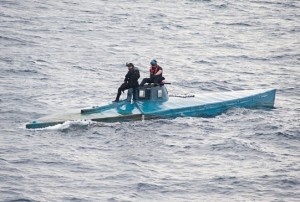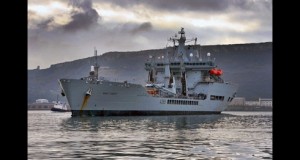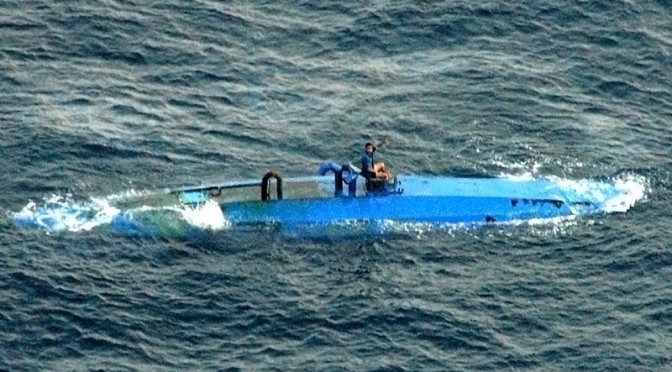By W. Alejandro Sanchez.
On March 12, 2015, Marine General John Kelly, commander of U.S. Southern Command (SOUTHCOM), testified before the Armed Services Committee about the security challenges that the United States and its Western Hemispheric allies face throughout the continent. In his Posture Statement, the general noted that SOUTHCOM is the U.S. military’s “lowest priority Geographic Combatant Command, hence the maxim ‘doing less with less’ has a disproportionate effect on our operations, exercises, and engagement activities.”
One particular focus of General Kelly’s remarks was transnational crime, specifically drug trafficking that originates in South America and crosses the Greater Caribbean towards the United States. There are several types of transnational crime occurring throughout Caribbean waters; due to space constraints, this commentary will only focus on the transportation methods utilized to move drugs throughout the Caribbean Sea and what this means for the security of the United States and its allies.
Low Priority & Insufficient Assets?
In his Posture Statement, General Kelly stated that Washington’s allies in the Western Hemisphere “are frustrated by what they perceive as the low prioritization of Latin America on our national security and foreign policy agendas, which is especially puzzling given the shared challenge of transnational organized crime.”It is not surprising that Latin America and the Caribbean are a low security priority for the United States, as the White House has had to deal with security crises elsewhere over the past years, such as the conflict in Ukraine, tensions with Russia, the Iran nuclear deal, and the Islamic State. Moreover, sequestration and other defense budget cuts have forced SOUTHCOM to try to do more, or at least the same as before, with less funds. The SOUTHCOM commander went on to explain how “force allocation cuts by the Services… are having the greatest impact… We are already feeling the impact at our headquarters, where we have implemented a 13% reduction in civilian billets and an 11% reduction in military ones.”
A similar situation is occurring with the U.S. Coast Guard, which has a wide area of operations in the

Caribbean. For the USCG, one immediate challenge is upgrading its aging equipment. Admiral Paul Zukunft, the Coast Guard’s Commandant, stated in April, “much of the Coast Guard’s infrastructure and many of our platforms are well beyond their service life.”
Both the SOUTHCOM commander and the Coast Guard Commandant have pointed out the challenge that transnational organized crime (TOCs), e.g. drug trafficking organizations, pose to U.S. security. General Kelly has highlighted the types of illegal goods that criminals are moving throughout the Western Hemisphere, like“drugs—including marijuana, counterfeit pharmaceuticals, and methamphetamine—small arms and explosives, precursor chemicals, illegally mined gold, counterfeit goods, people, and other contraband.” Meanwhile, the Coast Guard’s 2014 security blueprint, the Western Hemisphere Strategy (WHS), explains how “organizations are able to quickly adapt to changes in their external environment, including everything from advances in technology to an increase in law enforcement activity… As maritime trade and travel have grown, criminal organizations have taken to the sea, using complex operations and tactics to avoid detection while in transit.” (Click here for an analysis of the Coast Guard’s WHS).
In other words, both Southern Command and the Coast Guard are well aware of the challenges posed by TOCs. However, defense cuts and other security priorities are affecting how well these agencies, among others, can play a role in improving security in the region. The United States’ Caribbean allies and extra-hemispheric partners (like the United Kingdom and the Netherlands) are actively working to crack down on Caribbean drug trafficking. However, given that the United States is the final destination for most of the drugs being moved around the Caribbean Sea, and given the still-limited resources of Caribbean states to stop drug trafficking through their territories (land and maritime), it would be ideal for U.S. security agencies to maintain a vibrant presence in the region, particularly since Caribbean drug trafficking entities have the funds, creativity, and willingness to constantly expand their methods of transporting drugs.
Narco-Methods of Transportation
As for criminals themselves, they are nothing if not (infuriatingly) resourceful and creative when it comes to thinking of new ways to move drugs across the Caribbean. As a disclaimer, I must highlight that one major obstacle with this analysis is that detailed information is sometimes not openly available regarding the specifications of narco-vessels. For example, U.S. Southern Command reported that the USS Kauffman, a frigate, interdicted 528 kg of cocaine aboard a vessel on June 17. Nevertheless, SOUTHCOM’s press release does not explain what kind of vessel it was, other than calling it a “narcotic-trafficking vessel in international waters in the Eastern Pacific” or a “suspected smuggling vessel.”
The information below about narco-vessels provide as much detailed information as this author has been able to find.
As part of my research for this report, I contacted the Implementation Agency for Crime And Security (IMPACS), a security branch of the Caribbean Community (CARICOM, an organization made up of 15 Caribbean states). CARICOM IMPACS explained that 80% of all illicit smuggling activity through the region that originated in South America is carried out through maritime means.
Speedboats / Go-boats: the standard method of transporting cargo. Just this past July, the Coast Guard cutter Dauntless, “along with the assistance of a Netherlands Coast Guard maritime patrol aircraft,”stopped a speedboat north of Aruba – on the vessel were six individuals carrying a cargo of 275 pounds of cocaine.
Narco Subs: The evolution of narco-submarines over the past two decades is quite remarkable. The first narco-sub was stopped in 1993 and it had a crude design: it was slow and made up of wood and fiberglass.

More modern narco-subs can be fully submersible, travel as fast as 11 miles per hour, with larger fuel tanks and space for cargo. Due to space issues, we cannot discuss the different types of narco-submarines. A comprehensive report by the Foreign Military Studies Office (FMSO) entitled “Narco Submarines: Specially Fabricated Vessels For Drug Smuggling Purposes” discusses them in detail, including estimated costs, separating them from semi-submersibles, low-profile vessels, and submarines. These vessels have become alarmingly popular in recent years, as the narco-traffickers have sufficient funds to construct them. Case in point, this past June 18, the U.S. Navy and Coast Guard intercepted a “semi-submersible craft” that was carrying the whopping cargo of 16,870 pounds of cocaine.
Narco-Torpedos: One new technology is static narco-containers (AKA Parasitic Devices). The FMSO report defines them as “containers which are bolted or magnetically placed on the bottom of freighters and other large cargo ships by cartel and organized crime frogmen.”Narco-torpedoes were found on the hulls of ships going from Latin America to Europe in 2013. I have been unable to find current examples of such containers being utilized in the Caribbean, but it stands to reason that they could be utilized as well, particularly as there is a great flow of goods through Caribbean ports en route to the U.S. and elsewhere. Narco-subs and narco-torpedoes are the next evolution of drug trafficking in the region and, so far, there seems to be no limit to how large and equipped narco-subs can become.
Inside cargo/fishing ships: Unsurprisingly, hiding contraband aboard vessels that apparently are carrying legitimate operations, such as fishing, continues to be an option for drug traffickers. For example, in early 2014 a U.S. Coast Guard helicopter operating out of a British Royal Fleet Auxiliary vessel, the Wave Knight, stopped a vessel that was carrying 45 bricks of cocaine. This is a memorable mission, not solely because of the amount of narcotics seized, but because this marked the first time that a U.S. Coast Guard helicopter was launched from a British ship. That same year, on March 15, a fishing boat was seized off the coast of Panama. The U.S. Coast Guard investigated the vessel and found 97 bales of cocaine.
Finally, it is important to note that smuggling aboard vessels is more prevalent in some areas. CARICOM IMPACS explained to the author that smuggling among fishing vessels is common among members of the Organization of Eastern Caribbean States (i.e. Dominica, Grenada or Saint Lucia) to French territories (i.e. Guadeloupe and Martinique) and Barbados. This is due to the fact that these nations have large fishing industries which are utilized as disguise for the flow of contraband.
Narco-Aircraft: Planes and helicopters are also utilized for moving drugs, though they seem to be less common than maritime methods of transportation. According to CARICOM IMPACS, air smuggling accounts for approximately 20% of narcotics shipments in the region, mostly around the Bahamas due to its geographical proximity to Florida (with Haiti and the Dominican Republic utilized as springboards between the two). Throughout my research for this report, I was unable to find recent incidents of air smuggling throughout Caribbean islands. A geographically close incident occurred this past May; a narco-plane, a Hawker twin-engine jet, crashed off the Colombian coast as it tried to flee from the Colombian Air Force. The aircraft reportedly left Venezuela and entered Colombian air space – authorities found 1.2 metric tons of cocaine among the wreckage. As for narco-helicopters, in 2013 the Costa Rican police cracked down on a criminal group that utilized helicopters to transport weapons and drugs along the country’s Caribbean coast.
The aforementioned list exemplifies how drug trafficking organizations employ a wide array of vessels and aircraft to move their contraband from South America, through the Greater Caribbean, and ultimately to the United States and Europe. Part of the reason for this variety is that drug trafficking groups use an “island hopping” strategy to move the narcotics – for example, a speedboat carrying cocaine may leave Venezuela and dock in Curacao; from there it will be put in another vessel until it reaches a different island, and from there it may be transferred a third time before it attempts to enter U.S. territory.
Shootouts At Sea?
One issue worth discussing is that most press releases that report on stopping suspicious vessels discuss the incidents as generally non-violent, or they are one-sided violent. At most, we hear about security forces that fire shots at suspicious vessels. For example, in January 2014, the aforementioned helicopter, launched from the HMS Wave Knight, fired warning shots at the suspicious

vessel. “It was a unique and successful mission,” said U.S. Coast Guard Lt. Cmdr. Gabe Somma. “We fired warning shots, and they tossed [the drug-filled] bails.” Meanwhile, a March 2014 operation included a Coast Guard helicopter shooting at the engines of a ship in order to stop it.
The interesting issue here is that both incidents include security personnel shooting at suspected drug traffickers but not the suspected criminals shooting back. There are some official videos available online of suspected drug smugglers being chased by U.S. security forces, but the footage seems to show the fleeing drug traffickers more than actively engaged in a firefight (video 1, video 2). Certainly, criminals have no problem shooting at security forces – just this past May, a Mexican military helicopter had to make an emergency landing when it was shot at by gunmen (three soldiers were killed). However, in the Caribbean, incidents of drug traffickers aboard speedboats shooting at security agencies appear to be less common (or at least, under-reported). Nevertheless, the possibility that drug traffickers could become more actively violent in order to evade capture–switching from a release cargo-and-flee strategy to actively shooting at security agents–is worrisome. (While this commentary focuses on drug trafficking, there is also an active weapons trade through Caribbean waters; hence it stands to reason that criminals could use weapons in their possession/cargo, such as rifles and handguns, to attack security agents trying to stop them).
Nowadays SOUTHCOM, U.S. Navy South/4th Fleet, and the U.S. Coast Guard must do “more with less” at a time when the U.S. defense budget is undergoing significant cuts, and, as General Kelly correctly points out, SOUTHCOM has the least priority of all the other U.S. military commands. On the other hand, drug trafficking criminals are constantly thinking of new, more ingenious ways to move their illegal merchandise across the Caribbean Sea. Spotting narco-vessels may become even more difficult in the near future, particularly if narco-subs become more advanced and if narco-torpedoes become more popular.
Moreover, drug traffickers may eventually decide to be bolder and shoot back at security forces rather than flee. This may be the case if a particular cargo is deemed as too expensive to be lost. I have been unable to find cases of narco-speedboats having built-in machine guns, but this is certainly a possibility.This is not meant as an alarmist declaration but rather an assessment of how the situation is evolving in the Greater Caribbean.
Concluding Thoughts
In his March 2015 Posture Statement to the Armed Services Committee, General Kelly declared,“I am frustrated by the lack of a comprehensive U.S. government effort to counter the [transnational organized crime] threat.” Documents like the 2014 Coast Guard’s Western Hemisphere Strategy similarly explain the problem posed by TOCs, including those involved in drug trafficking, and the steps that can be taken to counteract them. The challenge nowadays for SOUTHCOM and the Coast Guard is having a budget that allows for the necessary personnel and equipment to carry out these objectives. General Kelly stated, “If sequestration returns in FY16, our ability to support national security objectives, including conducting many of our essential missions, will be significantly undermined. “
The goal of this analysis is not to imply that the U.S. government should give SOUTHCOM and/or the Coast Guard a blank check for obtaining new weapons. Nor should Washington solely focus on stopping the transportation of drugs through the Caribbean, while dismissing the other sides of the drug-equation, which includes demand (in the U.S. and European markets) and production (in South America). Rather, while the demand and production remain (unfortunately) vibrant, the interdiction of illegal narcotics among the various narco-corridors of the Greater Caribbean must remain a priority for SOUTHCOM and its supporting agencies like the Coast Guard, the Drug Enforcement Administration, the Department of Homeland Security, just like it is a national security priority for Caribbean nations and and regional security agencies like CARICOM IMPACS.
While Washington does not regard developments in Latin America or the Greater Caribbean as a security priority (at least not comparable to developments elsewhere in the world), criminal organizations, particularly drug trafficking entities, continue to operate in areas like the Greater Caribbean. The list of vehicles used to transport drugs through that region demonstrates how drug trafficking groups continue to imagine creative new methods to move their illegal merchandise. Moreover, the rise of the narco-submarine is a problematic development as these vessels could become harder to spot in the near future, particularly as narcos have the funds to support their construction. The seizure of a narco-submarine just this past July is a clear example that narcos have not given up on these vessels.As General Kelly said, “criminal organizations are constantly adapting their methods for trafficking across our borders.”
W. Alejandro Sanchez is a Senior Research Fellow at the Council on Hemispheric Affairs (COHA) where he focuses on geopolitics, military and cyber security issues in the Western Hemisphere. The author would like to thank CARICOM IMPACS for their assistance with this project. Follow him on Twitter: @W_Alex_Sanchez.

